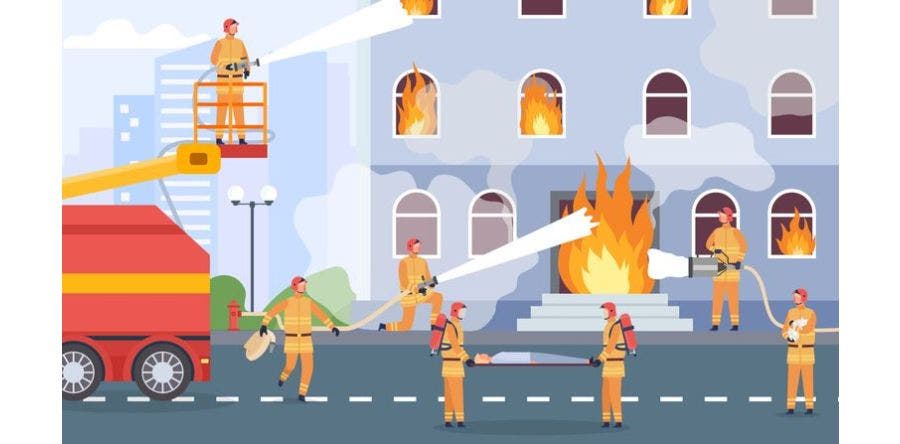Common Causes of Fires in Buildings
Identifying and Addressing the Risks
Fires can be devastating, causing loss of property and, more importantly, lives. In the United States alone, there are over 1.3 million fires each year, resulting in approximately 3,500 deaths, 16,000 injuries, and $14.8 billion in property damage, according to the National Fire Protection Association (NFPA).
These numbers are staggering and underline the importance of identifying and addressing the risks that can lead to fires in buildings. In this article, we will discuss some of the common causes of fires in buildings and explore innovative ways to prevent them so you can create a solid foundation for safety.
Understanding Common Causes for Building Fires
There are numerous reasons why fires can occur in buildings, ranging from electrical malfunctions to human error. Some of the most common causes include:
Electrical Issues
One of the leading causes of fires in buildings is electrical malfunctions. Faulty wiring, overloaded circuits, and outdated electrical systems are all common culprits. According to the National Fire Protection Association (NFPA), electrical issues account for 13% of all building fires in the United States. Regular electrical inspections can help identify any potential issues before they become a fire hazard. Additionally, proper electrical installation, maintenance, and usage can significantly reduce the risk of electrical fires.
Cooking
Unattended cooking is a significant risk, especially in residential buildings. According to the NFPA, cooking fires account for 49% of all residential building fires in the US. It's crucial to never leave cooking unattended and to ensure that kitchen appliances are in good working order. Additionally, building managers should establish proper fire safety protocols for cooking, including having fire extinguishers and emergency exit signs within reach.
Smoking
Cigarettes, cigars, and pipes pose a high risk of fire, and smoking should be prohibited in all buildings. According to the NFPA, smoking materials are the leading cause of fire deaths in the US. Building managers should establish designated smoking areas that are away from any potential fire hazards. Additionally, smokers should be educated on proper disposal of smoking materials, including using designated ashtrays or disposing of them in water.
Heating Systems
Heating systems, including space heaters and furnaces, can also pose a fire risk. It's important to have these systems inspected regularly and to ensure that they are properly maintained and used according to the manufacturer's instructions. According to the NFPA, heating equipment is responsible for 15% of all building fires in the US.
Building managers should establish proper safety protocols for heating systems, including maintaining a clear space around heaters, using only approved fuel sources, and having emergency exit signs and fire extinguishers readily available.
Put Fire Prevention Measures into Action
Preventing fires in buildings requires a comprehensive approach that involves identifying potential fire hazards and implementing measures to address them. Some prevention measures include:
Regular Inspections
Regular inspections of electrical systems, heating systems, and other potential fire hazards can help identify and address potential issues before they become a fire hazard. Regular inspections can also help ensure that fire suppression systems are installed and maintained properly to ensure they are in good working order.
Fire Suppression Systems
Fire suppression systems such as sprinklers and extinguishers are essential in containing and extinguishing fires before they cause significant damage. It's important to ensure that these systems are installed in the right locations and maintained properly to ensure they are in good working order. A faulty sprinkler system or an extinguisher that is not working can be catastrophic in the event of a fire, which is why regular maintenance and inspections are necessary.
Emergency Exit Signs
Required by law, these signs should be installed in all buildings, and it's important to regularly inspect and maintain them to ensure they are visible and functioning properly.
In the event of a fire, emergency exit signs can guide occupants to safety, which can mean the difference between life and death. Therefore, it's important to ensure that the signs are visible and the paths to emergency exits are clear at all times.
Employee Training
Proper training of employees is crucial to preventing fires in buildings. Workers should be educated on potential fire hazards, proper use of fire suppression systems, and emergency evacuation procedures.
Employees should also be trained on how to respond to fire alarms and when to evacuate the building. This training should be conducted regularly to ensure that all employees are aware of fire safety procedures.
Be Proactive, Not Reactive
Fires in buildings can have devastating consequences, but many can be prevented by identifying and addressing potential fire hazards. Regular inspections, fire suppression systems, emergency exit signs, and employee training are all crucial components of a comprehensive fire safety plan.
It's important for building owners and occupants to take fire safety seriously and take the necessary steps to prevent fires from occurring. By doing so, we can help protect lives and property from the devastating effects of fires. Work with the experts at Jessup Manufacturing to ensure your egress safety systems and emergency exit signage is up to date and installed properly to guide occupants to safety in the event of a fire.


















